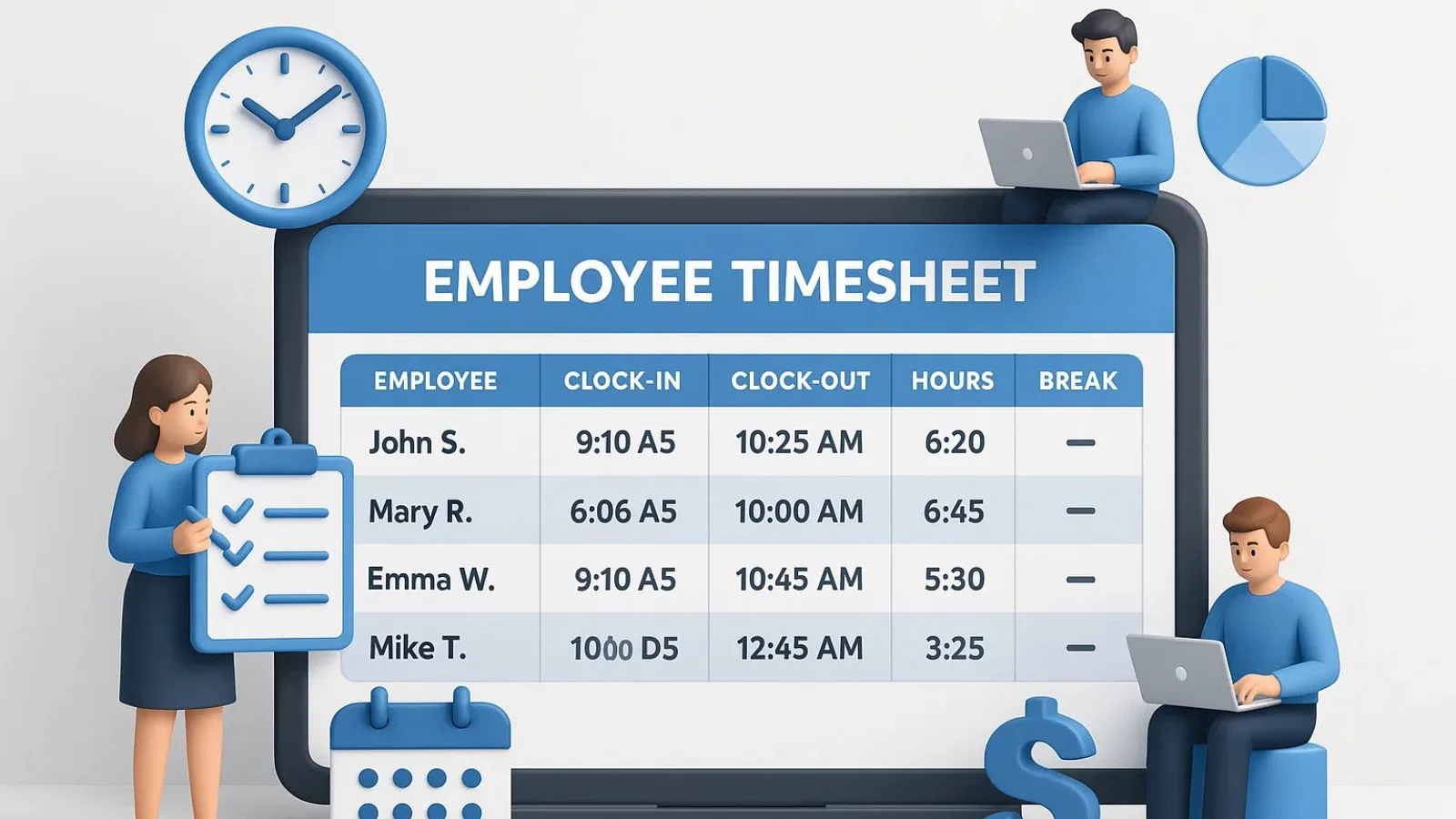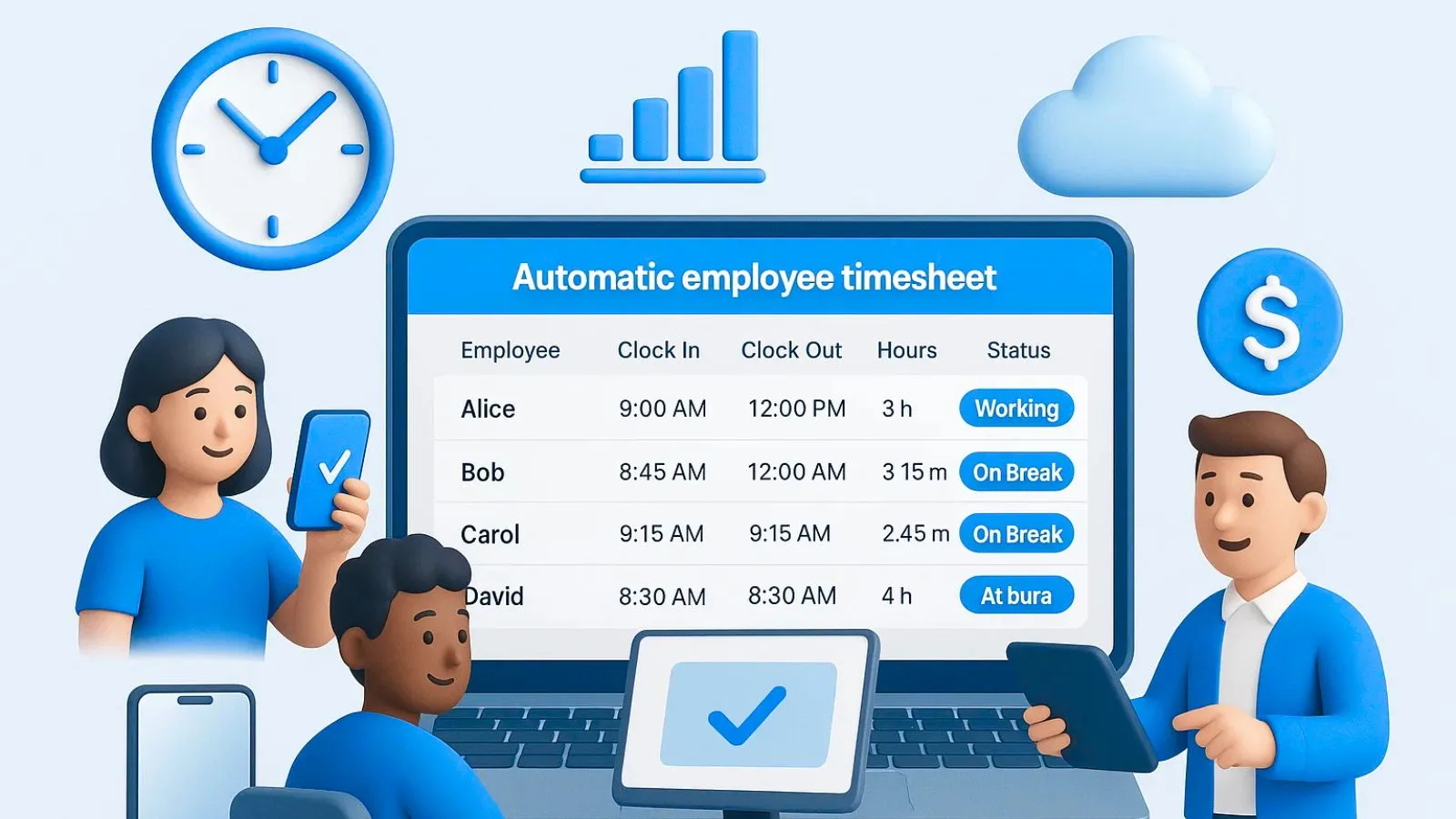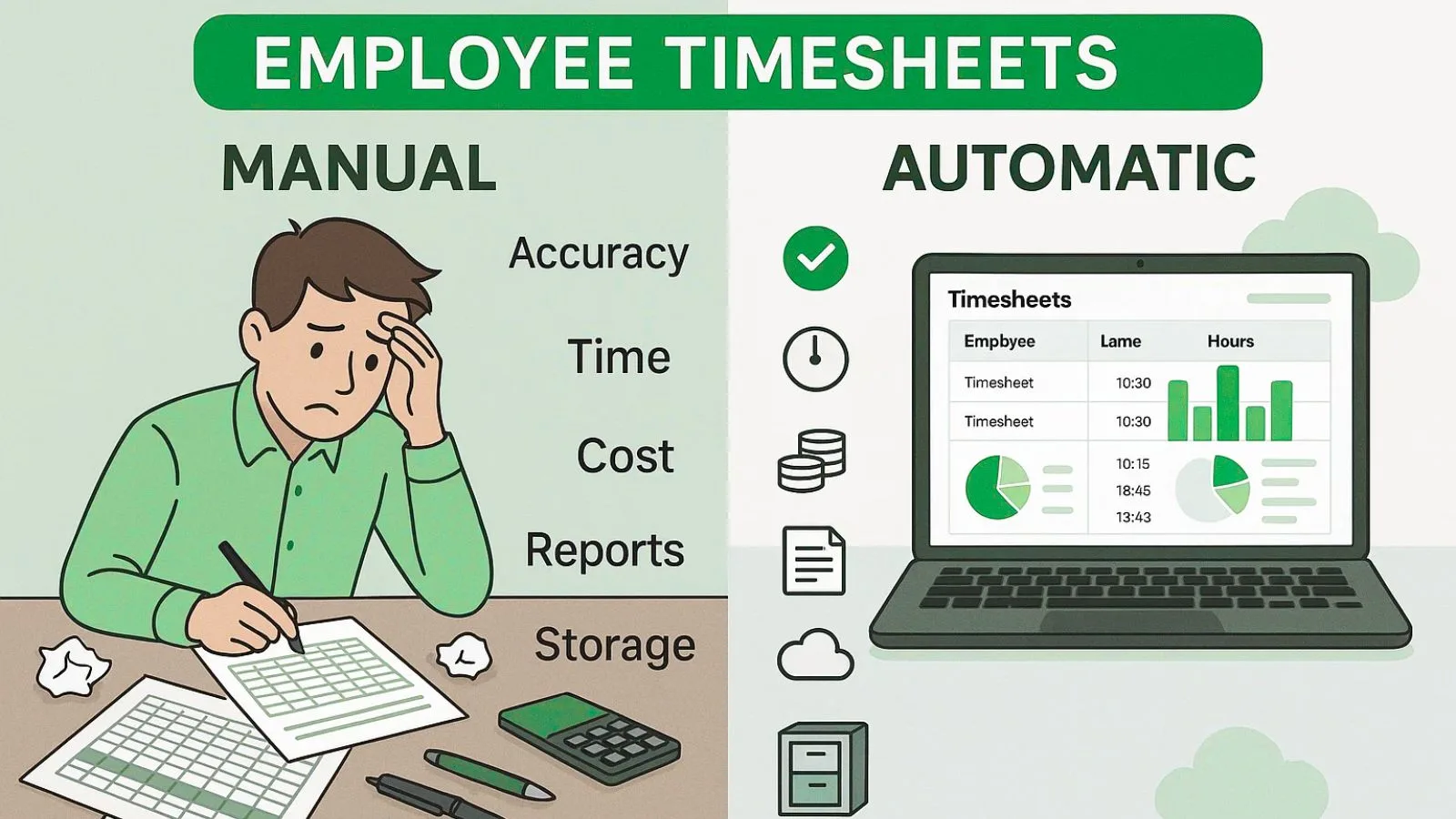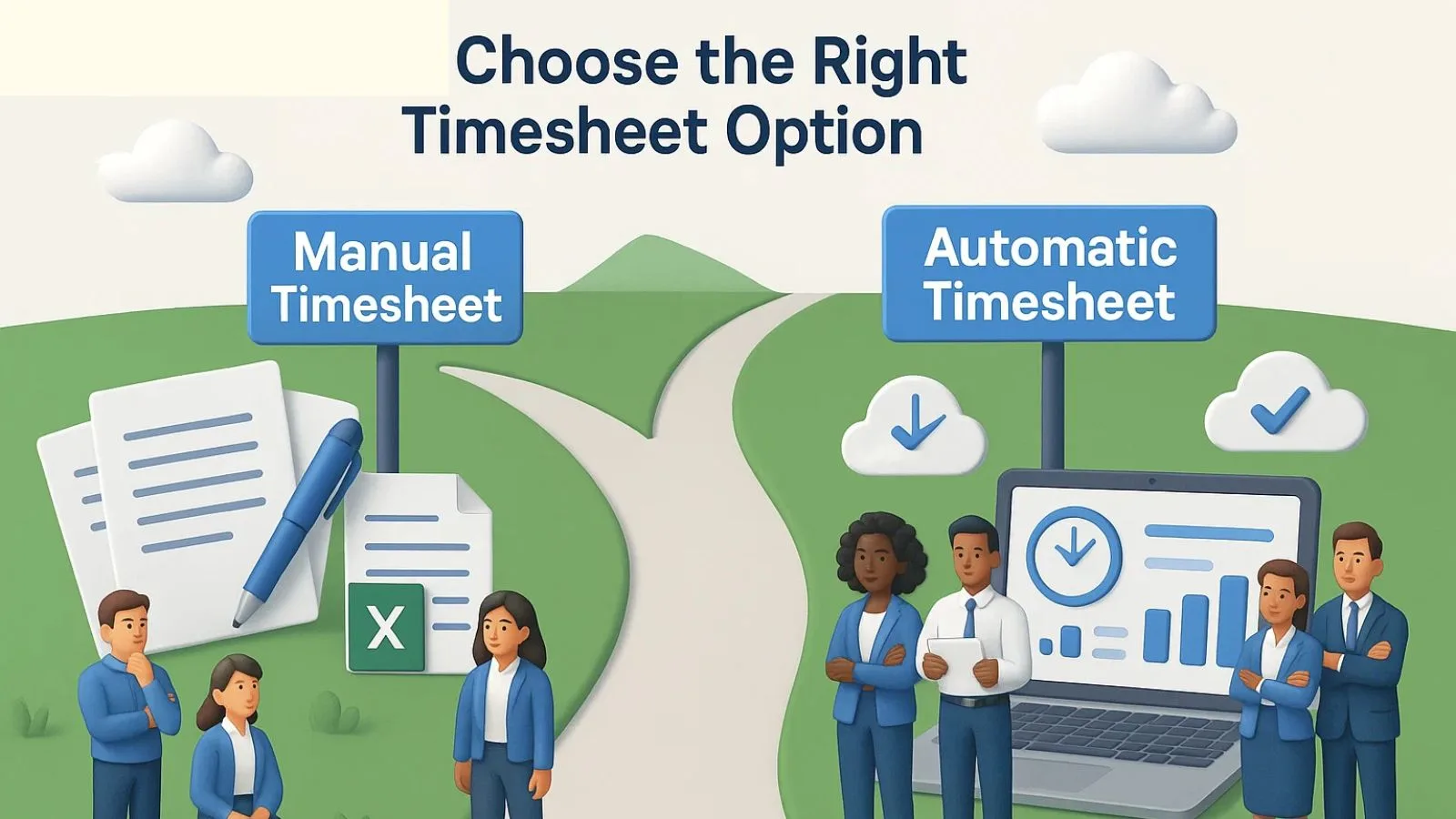Tracking work hours might seem like a simple task, but it plays a huge role in how smoothly a business runs. An employee timesheet is more than just a way to log hours; it’s the foundation for accurate payroll, better project management, and improved productivity.
But when it comes to timesheets, there’s always one big question:
Should you stick to manual timesheets or switch to automatic ones?
Manual timesheets, like paper logs or spreadsheets, have been used for years. They’re simple but come with limitations. On the other hand, automatic timesheets powered by employee timesheet software and time tracker tools offer a modern way to handle time tracking with less hassle.
In this blog, we’ll explore both options in detail. You’ll learn the pros, cons, and key differences between manual and automatic employee timesheets, helping you decide which one is better for your business.
Listen To Our Podcast!
What Is An Employee Timesheet?
An employee timesheet is a simple tool that helps businesses record how many hours their employees work. It tracks when someone starts working, when they finish, and sometimes even breaks or specific tasks.
Timesheets are important because they:
- Help calculate payroll accurately.
- Track project hours for billing clients.
- Monitor employee productivity.
- Keep a record of attendance and overtime.
Businesses use different methods to manage timesheets. Many still depend on manual tools such as paper logs or Excel-based timesheet templates. Others use modern tools like employee timesheet software or online employee timesheet systems that automate the whole process.
No matter the method, the goal remains the same tracking time in a way that’s simple, accurate, and efficient.
Manual Employee Timesheets 
A manual employee timesheet is the traditional way of tracking work hours. It usually involves paper sheets, printed forms, or Excel spreadsheets where employees write down their clock-in and clock-out times, breaks, and total hours worked.
Pros of Manual Employee Timesheets:
- Simple to Use: No need for software or internet.
- Low or No Cost: Paper sheets or a free employee timesheet template can get the job done.
- Good for Very Small Teams: If you manage just a few employees, manual tracking can be enough.
Cons of Manual Employee Timesheets:
- Time-Consuming: Manually filling, collecting, and calculating hours takes effort.
- Human Errors: Mistakes like wrong entries, missed hours, or incorrect calculations are common.
- Difficult with Multiple Employees: Managing a multiple-employee timesheet manually becomes confusing and error-prone as your team grows.
- Hard to Store and Search: Storing piles of paper or endless Excel files isn’t efficient for long-term record-keeping.
- No Real-Time Updates: You won’t know who’s working right now or track hours instantly.
Manual timesheets might seem easy at first, but as teams grow or work becomes more complex, they often cause more stress than solutions.
Automatic Employee Timesheets (Digital) 
An automatic employee timesheet uses digital tools like employee timesheet software, online employee timesheets, or time tracking software to handle time recording. Instead of writing hours down, employees simply clock in and out using an app, a web portal, or even an automatic timer.
These systems track hours in real time and often come with extra features like reports, payroll integration, and project tracking.
Pros of Automatic Employee Timesheets:
- Saves Time: No more manual entry. Everything is tracked automatically.
- Fewer Mistakes: No calculation errors, missed entries, or confusion.
- Great for Multiple Employees: Managing multiple employee timesheet becomes super easy with one dashboard for everyone.
- Real-Time Tracking: See who’s working and how long they’ve worked instantly.
- Accurate Reports: Generate detailed reports for payroll, attendance, or client billing.
- Remote-Friendly: Perfect for teams working remotely or in different locations.
Cons of Automatic Employee Timesheets:
- Setup Needed: You’ll need to set up the software and train employees.
- Software Costs: Most tools have subscription fees, but they save money in the long run by reducing errors and admin time.
- Learning Curve: Employees may need time to adjust to using the new system.
With tools like a time tracker tool or time tracking software, automatic timesheets offer a faster, more accurate, and stress-free way to manage employee hours, especially for growing businesses.
Manual vs. Automatic Employee Timesheets: Key Differences
Both manual and automatic employee timesheets help track work hours, but how they do it and how effective they are can be very different. Here’s a simple comparison to help you decide which one fits your business best.
Key Differences at a Glance:
| Feature | Manual Timesheet | Automatic Timesheet (Digital) |
| Accuracy | Prone to human errors | Highly accurate with minimal errors |
| Time Required | Time-consuming (manual entry & calculation) | Saves time with auto-tracking and auto-calculation |
| Cost | Low upfront (paper or free template) | Software costs but saves money long term |
| Ease of Use | Simple for very small teams | Easy with a small learning curve |
| Scalability | Difficult for growing teams or remote work | Scales easily with multiple employees |
| Real-Time Tracking | Not available | Available through online employee timesheet tools |
| Reports & Insights | Manual, basic | Automatic, detailed, and instant |
| Data Storage | Paper files or scattered Excel sheets | Cloud storage, safe and easy to access |
Quick Takeaway:
- Manual work for freelancers or tiny teams with very simple needs.
Automatic employee timesheet software is the better choice for businesses that want to save time, avoid errors, manage remote teams, and generate quick reports.
Read More
How Businesses Use Timesheet Templates To Save Time & Money?
The Unique Benefits Of Automated Timesheets
How to Choose the Right Option for Your Business?
Choosing between a manual and automatic employee timesheet depends on your team size, workflow, and how much time you want to spend managing timesheets.
When Manual Timesheets Make Sense:
- You have just 1-2 employees or freelancers.
- Work is simple, and hours rarely change.
- You don’t need detailed reports or real-time tracking.
- The budget is extremely tight.
A basic employee timesheet template in Excel or on paper might work for now.
When Automatic Timesheets Are the Better Choice:
- Your team is growing.
- You handle remote workers or hybrid teams.
- You need real-time tracking, accurate reporting, and easier payroll processing.
- Managing multiple employee timesheet manually is getting overwhelming.
- You want to save time, avoid mistakes, and focus on actual work.
Recommended Tool: EmpMonitor
If you’re leaning toward automation, EmpMonitor is an excellent choice. It’s more than just a time tracker tool; it’s a complete solution for employee monitoring and productivity management.
With EmpMonitor, you can:
- Track work hours automatically with an accurate online employee timesheet.
- Monitor employee activity in real-time, whether in-office or remote.
- Manage attendance, idle time, and productivity easily.
- Generate detailed reports that help with payroll, project tracking, and performance reviews.
- Scale easily from small teams to large organizations without the stress of manual timesheets.
EmpMonitor takes the headache out of time tracking and lets you focus on what truly matters: growing your business.
Conclusion: Manual or Automatic, Which Employee Timesheet Wins?
When it comes to tracking work hours, both manual and automatic timesheet methods have their place. But if we’re being honest, the workplace has evolved, and so have the demands of managing teams, projects, and productivity.
Let’s Recap:
- Manual employee timesheets are simple and cheap. They work for freelancers, very small businesses, or companies with extremely straightforward needs. If you only need to track a few hours a week and don’t mind doing the math yourself, a basic employee timesheet template might do the job.
- But the moment your team starts growing, whether that’s adding more employees, handling remote staff, or working on multiple projects, manual systems start to show their cracks. Lost papers, incorrect entries, and endless hours spent sorting spreadsheets become a real headache.
Why Automatic Timesheets Are the Future?
Switching to an automatic timesheet software isn’t just a convenience; it’s a smart business move. Here’s why:
- Saves Time: Time spent chasing people for timesheets or fixing mistakes adds up fast. Automation eliminates that.
- Accurate Data: Automated timesheet software prevents errors in hours, overtime, or billing, meaning smoother payroll and happier employees.
- Real-Time Monitoring: Know who’s working, when, and on what tasks, no matter where your team is located.
- Better Insights: Want to know how much time your team spends on certain tasks? Or who’s consistently logging overtime? Tools like EmpMonitor give you answers in seconds.
- Increased Accountability: Employees become more conscious of their time when they know it’s being tracked automatically, often leading to better productivity.
- Scalable: Whether you have 5 employees or 500, managing a multiple employee timesheet with automation is just as simple.
Why is the EmpMonitor the Best Choice?
If you’ve realized that manual tracking is holding your business back, switching to a powerful tool like EmpMonitor can change everything.
EmpMonitor isn’t just a time tracker tool. It’s a full suite for workforce management. You get:
- Automatic online timesheet tracking.
- Real-time employee activity monitoring is perfect for remote teams.
- Detailed productivity reports that show who’s working effectively.
- Idle time detection, project-based time tracking, and more.
- Easy integration into your workflow without the stress of juggling paper sheets or Excel files.
With EmpMonitor, you go beyond just tracking hours. You gain the ability to truly understand how time is spent in your company, find inefficiencies, and boost productivity.
A Final Thought:
In today’s fast-paced work environment, businesses need tools that save time, reduce stress, and help teams stay focused. While manual timesheets had their place once upon a time, modern businesses need modern solutions.
If you value accuracy, efficiency, and peace of mind, automatic timesheets powered by tools like EmpMonitor are hands-down the better choice. You’ll spend less time on admin tasks and more time focusing on growing your business.
FAQs About Employee Timesheets
What Is An Employee Timesheet?
An employee timesheet is a tool that tracks the number of hours an employee works. It helps businesses calculate payroll, monitor productivity, and keep accurate attendance records. Timesheets can be either manual (paper or Excel) or automatic through employee timesheet software.
What Is The Difference Between Manual And Automatic Employee Timesheets?
- Manual timesheets require employees to record hours themselves, usually on paper or using an employee timesheet template in Excel.
- Automatic timesheets use time tracking software or a time tracker tool to track hours digitally, offering real-time data, error-free calculations, and reports.
Why Should I Use Employee Timesheet Software?
Using timesheet software saves time, reduces errors, and makes managing a multiple employee timesheet much easier. It offers real-time tracking, accurate reports, and better payroll management. Tools like EmpMonitor also track productivity, not just hours.
Is Online Employee Timesheet Software Secure?
Yes, most modern online timesheet tools, including EmpMonitor, use encrypted cloud storage, data protection protocols, and user authentication to keep your business data safe.
Is Using A Free Employee Timesheet Template A Good Option?
Yes, free templates work for very small businesses or freelancers. But as your team grows, switching to automated tools like time tracking software becomes more efficient, reliable, and scalable.
How Does an Empmonitor Help With Time Tracking?
EmpMonitor automates your timesheet process. It tracks work hours, monitors active and idle time, and generates detailed reports. It’s perfect for remote teams and businesses looking to improve productivity while making time tracking stress-free.
Is Time Tracking Legal For Employees?
Tracking employee work hours is legal in most regions, provided it’s done transparently and employees are informed. Solutions like EmpMonitor not only make time tracking efficient but also help businesses stay compliant with labor regulations while promoting accountability and productivity.














